James Brown's Japanese Cup-O-Noodles Commercial
Wow. Wow. Wow. Wow! As they so often do, the guys at Ego Trip have discovered something amazing.
11 Completely Scientific, Not At All Dubious Diets From Our Recent Past
by Emily Morris

In 1918, Lulu Hunt Peters’ Diet and Health, with Key to the Calories introduced Americans to the concept of “calorie counting,” and the modern diet was born. Realizing that counting calories was no fun, America took the concept and turned it into a game to see who could promise the best results for the least effort in the shortest amount of time — while also making the most money off it! You know, the American way. Dieters in this country spend $40 billion per year on weight loss programs, many of them fad diets. Here are some of the most questionable to have appeared along the way; if any of them strike you as particularly whack, blame Lulu.
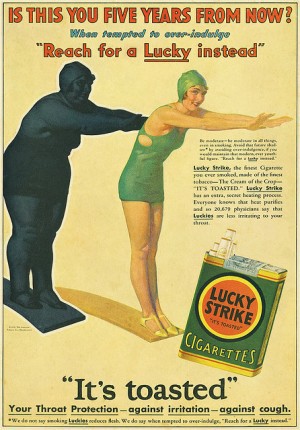
Name: “Reach for a Lucky Instead of a Sweet”
Years Active: 1927
Method: Admittedly, not so much of a diet as an ad campaign. Still, why not just cut out the middleman, or “food,” all together?
Sample Meal: First- and secondhand smoke.
Name: The Grapefruit Diet
Aliases: Hollywood Diet, Mayo Clinic diet
Years Active: 1930s-40s
Method: The Grapefruit Diet consists of eating a grapefruit at breakfast, lunch and dinner, along with a vegetable or a scrap of toast. It was spoofed in this song by Weird Al (of course), as well as in the 1933 film Hard To Handle. In it, the main character, a grapefruit farmer named Lefty Merrill, begins the latest diet craze, called “The 18 Day Grapefruit Diet” (although, given that the diet in the movie is an exact replica of the real one, “spoofed” might not be the word). In the ’40s the plan became known as the Mayo Clinic Diet, though it was in no way affiliated with the actual Mayo Clinic. Iterations of the Hollywood/grapefruit/fake Mayo Clinic continue to exist, and probably will as long as grapefruits roam the earth.
Sample Meal: A grapefruit, an egg and black coffee. Add a piece of Melba toast if you must.

Name: The Cabbage Soup Diet
Aliases: The Mayo Clinic Diet (again), TWA Stewardess Diet, Dolly Parton Diet, and Model’s Diet. The name changes nicely reflect the decades in which this diet has re-appeared.
Years Active: 1950-present
Method: Along with the grapefruit diet, the cabbage soup diet is one of those ubiquitous fad diets that you always hear from people on weight loss surgery shows: “I’ve tried everything. Weight Watchers, Slim Fast, grapefruit diet, cabbage soup…” and they trail off because there are more, they just can’t think of them right now. In any case, it’s easy to fail the diet’s 7-day meal plan. Its strict, arbitrary rules lend itself to very little except driving yourself crazy.
Sample Meal: On day four of seven, you can eat “as many as eight bananas and up to eight glasses of skim milk” along with your soup. On day five, have a reasonable 10–20 ounces of steak and up to six fresh tomatoes.
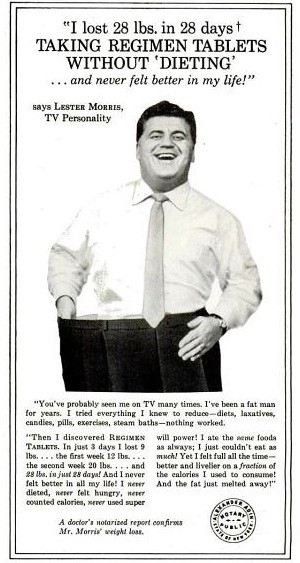
Name: Regimen Tablets
Years Active: 1956–1960
Method: Like all the best diet pills, Regimen Tablets required neither “special eating” nor a doctor’s prescription. Pure science is at work here, as evidenced by item number 3 on the ad: the tablets “start traveling quickly through your blood stream, and you lose the TREMENDOUS URGE TO EAT.” What’s more, two whole doctors “Prove No-Diet Reducing.” While these advertisements created the template for diet advertising today, they’re still reminders of more innocent times. Lester’s testament is stamped by a notary public. And he’s wearing a shirt and tie in his “look, big pants” picture. Aww.
Sample Meal: Lester says you can eat anything you want, and I trust him completely.
Name: Ayds Reducing Diet Plan
Years Active: 1970s
Method: Sales for this unfortunately named “appetite suppressant chocolate” plummeted 50% in the mid-’80s. No one knows why.
Sample Meal: Anything healthy, as long as it’s preceded by an Ayds chocolate. Ayds go best with a hot drink.
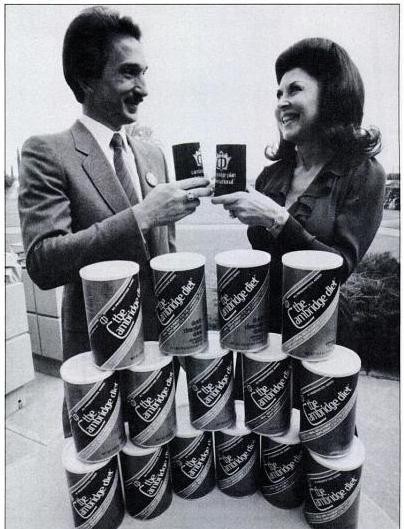
Name: Cambridge Liquid Diet
Years Active: 1981–1985, still has a website
.
Method: Ads for the “Incredible” Cambridge Liquid Diet cut to the chase: “ACTUALLY REDUCES BODY FAT AS FAST AS FASTING OR COMPLETE STARVATION.” A precursor to Slim-Fast, the Cambridge Diet protein drink was flavored with Dutch chocolate and came in powder form. For some, the rapid weight loss led to heart failure, and the F.D.A issued a public warning on the label. The Cambridge System has since grown to include soups and “nutrition bars” in addition to their original drink. (Note: Cambridge Liquid Diet had the same manufacturer as the Mark Eden bust developer.)
Sample Meal: Choose between Chocolate, Vanilla, Strawberry, Eggnog, and Cappuccino flavors. Don’t worry, if you really can’t decide, there’s always your next meal, and all the meals after that for a month.
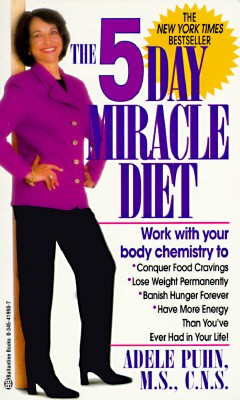
Name: The 5 Day Miracle Diet (and 1-, and 3-, and 4-Day variations…)
Years Active: 1996
Method: There are a host of plans that boast quick weight loss in just a work week (or less.) Most are standard low-carb, good-fat, grapefruit-slinging affairs, but my favorite is one published in 1996 by Adele Puhn under the name “The 5-Day Miracle Diet,” where she calls out the “fathead” as the source of emotional eating:”Once you’ve lost the physiological needs that are 75 percent of your problem, I will show you how to deal with the remaining 25 percent. That makes up your fathead…” The book’s introduction is titled “I Was Born In A Box of Cookies.” This diet was probably an inspiration for 90% of all “Cathy” strips.
Sample Meal: Salad with tuna fish, lite yogurt, green tea. I’m assuming you’re supposed to repeat this diet. Every 5 days. Over and over. Forever.
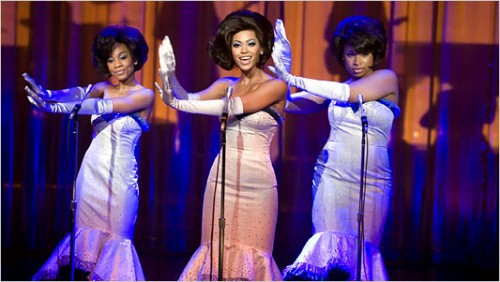
Name: Master Cleanse
Aliases: Lemonade Diet, Maple Syrup Diet
Years Active: 1990s — present
Method: Originally created by alternative medicine practitioner Stanley Burroughs, the Master Cleanse was promoted heavily by Peter Glickman in the 1990s. The lemonade, maple syrup, and cayenne pepper mixture is said to rid the body of various “toxins,” though it’s primarily used as a quick weight-loss fix. Beyoncé famously
“detoxed” with the Master Cleanse in order to play Deena Jones in Dreamgirls.
Sample Meal: Meals are for the weak.

Name: Atkins
Years Active: 1972- present; resurgence in early 2000s
Method: “Atkins” became an all-inclusive term for the high-fat, low-carbohydrate (or no-carbohydrate) diet trend of the early aughts, where a bacon-topped meatloaf was preferable to a slice of bread. The introductory chapter of Dr. Atkins’ New Diet Revolution, published in 2001, anticipates the question “What’s Wrong With Carbohydrates?” and answers, “If you mean what’s wrong with a spear of broccoli or a bunch of spinach, the answer is nothing, they’re magnificent foods.” Oh, snap. You told bread. Atkins seems to go out of fashion whenever adherents a) have heart attacks from the amount of red meat they’re consuming or b) realize that their love for pasta is not optional, only to be resurrected again in the next cycle of branding. It’s due for a comeback any day now.
Sample Meal: Cauliflower “Potato” Salad, for when you want to disappoint everyone at your barbeque.
Name: The GenoType Diet
Years Active: 2007 — present
Method: The book The GenoType Diet (2007) begins with a Freud quote: “Anatomy is destiny.” Uh oh. Its premise is that everyone can be divided into one of these six types: The Hunter, The Gatherer, The Teacher, the Explorer, the Warrior, and the Nomad. Measurements from your legs, torso, index finger and ring finger, as well as your fingerprint pattern, determine your type and the meal plan you should follow.
Sample Meal: Depends on your type. The Teacher, for example, should stay away from all poultry except for emu, ostrich, squab and turkey. The Teacher should also note that while eggs from chicken are fine, herring roe is OUT OF THE QUESTION.
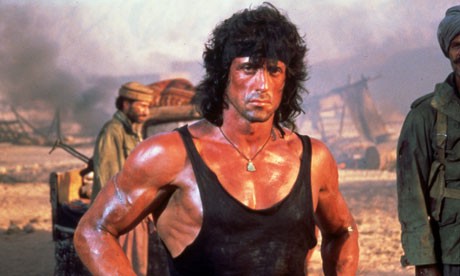
Name: Human Growth Hormone
Years Active: 1990 — present
Method: According to WebMD, Human Growth Hormone (HGH) is produced naturally by the pituitary gland to “fuel growth and development in children,” maintaining bodily functions like tissue repair, brain function and metabolism. Ding ding ding! That tidbit of science prompted the New England Journal of Medicine to publish a study in 1990 showing that “injections of synthetic HGH resulted in 8.8% gain in muscle mass and 14% loss in body fat without any change in diet or exercise.” This sci-fi diet has since been denounced by several more studies, including one by the New England Journal of Medicine in 2003. Yet synthetic HGH continues to be sold as a weight-loss tool on the Internet (as Sylvester Stallone can attest).
Sample Meal: ChickieNobs, followed by your daily injection.
Emily Morris is a summer Awl reporter.
Lucky Strike ad via clotho98; cabbage photo by La Grande Farmers’ Market.
Lil B's Big Gay Album And The Current Marvin Gaye Moment In Rap
“I’m ready to give up my old thoughts/I’ma move past what a saw/I’ma do what a want and be happy/I’m not gonna rob or kill to survive/Everything I seen was a lie/I’m not ready to die/I love myself…” — Lil B, “I Hate Myself.”
“Evolve already,” said the button Dan Savage wore to a Gay Pride reception at the White House last night. Well? Oakland rapper Lil B, at least, seems to be listening. His new album, I’m Gay (I’m Happy) came out yesterday on iTunes. I’ve been listening to it this morning, and it sounds really good.
Of course, there is the basic level good of a prominent artist choosing “I’m Gay” as a title for a rap album. And Lil B has been saying nice things about it, too.
“I hope that I can turn some of my fans that might be homophobic or supporters that might be homophobic and say, “You know what, we’re all one people. This is love.” It’s just respect, and I did that to bring people together and bring more love and to spark the minds of people and not let words and judgments and stereotypes stop you from loving.”
There are other interesting things to talk about. And if I had more time this morning, I would try think of a more fluid transition to write here.
The cover of the album is an homage to that of Marvin Gaye’s 1976 classic, I Want You, with Ernie Barnes’ famous painting “Sugar Shack,” which was also featured in the opening credits to the TV show “Good Times.”
Gaye’s influence on hip-hop, always huge, has been especially prominent lately, with Tyler the Creator stating a preference for boogieing to his music in pink panties in “Yonkers,” and Drake naming his new song “Marvin’s Room,” after the late singer’s personal recording studio (where it was recorded) and everybody else jumping on the track to make their own versions. And Big Sean with Roscoe Dash and Kanye West setting the mood with “Marvin Gaye and Chardonnay.”
Here’s another good song from “I’m Gay.”
Gay, Gaye, Game… I have a terrible weakness for bad puns and childishly obvious word play. And no idea what to do about a title for this post.
Previously: Rap Music Is Good Now Because Rappers Aren’t Afraid To Be Weird
"Transformers: Dark of the Moon"

Perhaps you know him best as the whimpery gay dude in rehab in the bizarre Sandra Bullock vehicle 28 Days? Perhaps you know him as the creepy murderer in television’s messy yet underappreciated scifi body-swapper mystery “Dollhouse.” Or maybe you know him most from the very best episodes of the very best TV show, “Strangers with Candy,” when he played the leader of the cult that wanted to “sit at the welcome table.” As Steve the Pirate in Dodgeball? That dude from “Firefly”? The pedophile on “CSI”? I would call him the man of a thousand faces but he really has just one face and it’s magical! Oh, Alan Tudyk! His latest role is that of an insane and likely Austrian and definitely repressed computer hacker and reformed assassin and probable homosexual in Transformers: Dark of the Moon and he achieves the feat of being the one actor who openly mocks this hideous and outrageously expensive-looking film from within. YOU WIN, Alan Tudyk! You are the best.
And the competition is tough: there’s a spray-tanned John Malkovich going real big; an absolutely bonkers physical comedy endurance routine from Ken Jeong; Frances McDormand vacillating between phone-in and terrifying commitment as a chief spook; a big and effortlessly campy John Turturro splatter-painting of a performance. That is a lot of actors trying things without much supervision and, to be fair, they’re all winners in the losing battle of man versus machine.
You know that it goes without saying that this is a terrible movie. (And unlike MANY of you OTHER pretend film critics (ahem), I have indeed seen them all three Transformers movies. Not only that, I have seen the entirety of the monster bomb that was GI Joe, so I know where the baseline is.)
Knowing that, the point becomes: is this a movie that you can slip into and forget about your life for a few hours? The answer, happily, is “mostly yes.”
There are the appearances of plot obstacles to be resolved. It’s not all too confusing. The dialogue is jarring and nonsensical and very broad with lots of swearing, so it keeps you engaged and you forget that you’re watching Hasbro toys. Shia Labeouf talks a lot. His girlfriend juts her parts as needed.
But on a scale of terribletude, it’s really so much better than the other two Transformers movies! There is actually some attention paid to some visual staging and someone decided that there should be a story, and then made sure to express every nook and cranny of the story in real-time, and then helpfully gave us flashbacks to very slightly earlier in the movie! (Remember that part where humans went to the moon and found aliens, which was also the main point of the movie’s trailer (and also THE SUBTITLE) which you have been shown 1000 times? Well JUST IN CASE you didn’t remember the CENTRAL PREMISE OF THE MOVIE, here are some little flashbacks! That is unreal!)
And somehow still, there was a point at which I started working out a tax issue in my head and then came back when I remembered I was at a movie. So it’s not a total success.
What I’ll remember most about this final Transformers movie is that there were three different U.S. presidents in the film and somehow they couldn’t find an actor who looked like Kennedy, Nixon or Obama. (This is Brett Stimely, the dude who played Kennedy. I mean, why not just pick any random white person off the street?) In a movie that is mostly made of pixels, that just seems impossible, or perhaps actively hostile.
Newlyweds Acknowledging Crushing Realities of Marriage
Today in alleged trends discovered by surveys commissioned by companies who directly benefit from said trends: “Newlyweds are increasinly breaking with tradition and picking tongue-in-cheek songs for their first dance like ‘I still Haven’t Found What I’m Looking For.’ The U2 hit is among the more bizarre choices raising eyebrows. Others include Morrissey’s ‘You’re the One for Me Fatty’ and classic ska track ‘Shotgun Wedding’ by Roy C…. Other choices to cause a double take include Joy Division’s classic ‘Love Will Tear Us Apart’ and Queen’s ‘I Want to Break Free’ said the research for H.Samuel.”
The 'Village Voice' Prepares for Strike While Ashton Kutcher Rages
by Myles Tanzer

Tonight at midnight, the three-year contract at the Village Voice expires, so Voice workers held a strike benefit at Williamsburg’s Public Assembly last night. The bands were really loud and the crowd drank a lot.
The crowd was heavy with, yes, Village Voice staffers and their friends, as well as a handful of former-Voice employees there to show their support. Ex-employees in attendance included: Zach Baron (who left The Voice for The Daily back in March), Foster Kamer (of the New York Observer), and Tom Robbins (the influential writer who left the paper after the departure of long time columnist Wayne Barrett). Robbins’ appearance was perhaps the biggest “screw you” move of the night and was a reminder of the ever-more-corporate Village Voice. As was the arrival at the paper of Nick Pinto from the Village Voice Media’s (the parent company of The Village Voice) Minneapolis weekly City Pages.
Back in March, Pinto wrote the nationally printed and murky Voice cover story “Women’s Funding Network Sex Trafficking Study Is Junk Science.” The story defends Village Voice Media’s ownership of the classified site Backpage.com.
Backpage.com allows “adult ads” to be posted; last year a 15-year-old sex trafficking victim sued VVM for aiding and abetting prostitution. This week’s piece, by Martin Cizmar, Ellis Conklin and Kristen Hinman — which doesn’t have a lot of fans on the staff — was called “Real Men Get Their Facts Straight.” Billed online as “The Truth Behind Sex Trafficking,” it targets Ashton Kutcher’s “Real Men Don’t Buy Girls” campaign against U.S. underage sex trafficking.
The piece also pokes fun at estimates of underage sex workers, using arrest records from American cities. Because obviously the number of minors arrested for prostitution must somehow explain the number of minors in the sex business, right? A sidebar to the piece also blamed “feminists, religious zealots” and others for bringing Craigslist’s adult services section to a Congressional hearing.
A while after attendees of the benefit stumbled home from last night’s party, Ashton Kutcher took to Twitter to berate the Voice for their cover story.
Hey @villagevoice REAL MEN DON’T BUY GIRLS and REAL NEWS PUBLICATIONS DON’T SELL THEMless than a minute ago via web
ashton kutcher
aplusk
Kutcher’s 11 angry tweets to his seven million followers were apparently only the beginning.
Hey @villagevoice I’m just getting started!!!!!!!! BTW I only PLAYED stupid on TV.less than a minute ago via web
ashton kutcher
aplusk
The Voice answered back this morning.
Wow, @aplusk having a Twitter meltdown! Hey Ashton, which part this story is inaccurate? http://tinyurl.com/3nme6l8less than a minute ago via web
Village Voice
villagevoice
Meanwhile, Voice editor Tony Ortega took the time to joke about the union negotiations.
Going back into negotiations soon. Gotta be quicker with my jabs and uppercuts. Didn’t know Hoberman could move that fast.Thu Jun 30 14:58:34 via TweetDeck
Tony Ortega
VoiceTonyO
We hear Village Voice Media’s Executive Editor Mike Lacey is going to take control (has taken control?) of the Voice’s Twitter account today to fire back at Ashton. [UPDATE: We are told we hear wrong.]
Disclosures: Myles Tanzer worked previously at the Voice; The Awl is happily pro-labor.
Learning To Lip Sync: Five Early (Really Early!) Music Videos
Learning To Lip Sync: Five Early (Really Early!) Music Videos
by Nate Hopper
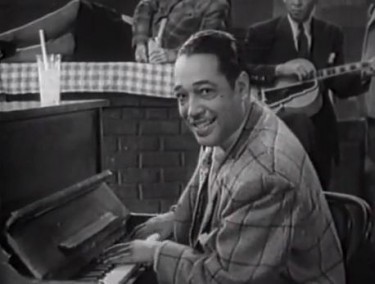
Back in 1940, some bars and nightclubs began replacing their jukeboxes with a newfangled contraption called a Panoram that could play short musical videos. Patrons couldn’t choose the order of the movies they saw; they’d plunk in a dime and whichever of the eight three-minute videos was next on the reel would be projected onto the machine’s two-foot screen. Although the reels sometimes featured sketch comedians, most of the movies showed quite literal enactments of a pre-recorded song, some by musical greats in their prime like Louis Armstrong, others by artists who were then still on their way to stardom, like Duke Ellington, Doris Day, Lena Horne and a young Liberace (if you can imagine that).
Called ‘Soundies’ — as Time noted for its readers, there’s an “s” on it even when referring to the singular — these videos were produced until 1947. Today they’re three-minute time capsules, revealing a nation preoccupied with WWII and stuck on stereotypes. It was also an America where pop artists were still figuring out sex appeal and how to use a camera, and who didn’t have lip-syncing quite mastered. Some of these Soundies are still fun to watch, others, less fun. Here are some of the best to be found on YouTube.
“Honeysuckle Rose” by Fats Waller
Fats Waller was known for his penchant for eating “only a dozen pork chops” when he wasn’t feeling hungry and a Salisbury steak every three hours when he was. During performances, he also liked shuffle his way over to a bottle — likely of Old Grand Dad whiskey — waiting on the wing of the stage. The bridge to “Honeysuckle Rose” was almost a couple of drinks away from existence. According to Fats’ son, Maurice Waller, in the biography he wrote on his father with Anthony Calabrese, Fats Waller, had it not been for Fats’ collaborator, Andy Razaf, writing the eight bars down after Fats had hummed them to him over a bar’s phone, the three gins Fats drowned as Andy worked them out back at the studio would’ve washed them away from memory.
“I Got it Bad (and That Ain’t Good)” by Duke Ellington, with Ivie Anderson
It’s a little surprising to see Ivie Anderson in a plaid dress in this one. In an article from Downbeat from the early 1940s, Ivie said, “When I first started with Duke [Ellington], I used to wear colored dresses. When he suggested I wear only white, I tried it out and found it so effective that I’ve been doing it ever since.” Anderson said she had it good with Ellington; in 1931, Anderson had signed a four-week contract to become the girl singer in his orchestra, and then held her spot for over 11 years. Many consider that time — before the 1943 Carnegie Hall shows that helped Ellington win enduring acclaim — as an important transitional period for Duke’s sound; during those years, people stopped dancing at his performances (as they did at other musicians’ shows) and began just listening. In his autobiography, Music is My Mistress, Ellington wrote of Ivie that, “every girl singer we’ve had since has had to try to prevail over the Ivie Anderson image.”
“A Study in Brown” by Reg Kehoe and his Marimba Queens
The bassist in this, Frank Denunzio Jr. (who passed away in 2005), is just wow.
“Lazy Bones” by Hoagy Carmichael
Hoagy Carmichael was political enough to try and start a fistfight with Humphrey Bogart over politics (his wife broke it up). The lyrics to his song, “Lazybones,” which sold 350,000 copies in three months, as well as its Soundies, are tinged with racial stereotypes. But the way he tells it, he didn’t mean it like that: “It was the coin of the day, the way people talked. It was part of our world. Nobody likes it… But the lyrics weren’t meant to be in any way deprecating, or ‘dissing’ anybody.” When writing with a collaborator the song’s follow-up, “Small Fry,” he was less guarded — though the song was heavily edited by Carmichael before its release. And Bing Crosby and Louis Armstrong went on to cover “Lazy Bones” together — listening to it might put you through a range of feelings.
“The Twelfth Street Rag” by Liberace
Only a few years before this was recorded, Liberace — then known as Walter — had been playing in a small concert hall in Wisconsin when, after he finished performing his planned set, he asked the audience for a request for his encore. As Bob Thomas writes in Liberace: The True Story, someone called out, “”Three Little Fishes” — the song with the chorus, “fim, ittle fishies, fim if you can, and they fam and the fam all over the dam” — to some laughter. And so Walter started back up, working his way through some Chopin flourishes, when he then began weaving the “Three Little Fishes” line in to the audience’s delight. He kept going, adapting the tune to the stylings of Mozart, Beethoven and John Philip Sousa. Many say it was that performance that taught Liberace how exciting the combination of classical and pop music could be, which led to songs like the one above and this one.
Nate Hopper is a summer Awl reporter.
Man Takes Productive Crap
“I was sitting in the bathroom reading one day, and I was sitting there for about an hour, and I realized that I was more comfortable on my toilet seat than I was on my bike seat,” says the guy who invented the new bike seat you see here. What have you done on the toilet recently? Tell us in the comments!
Previously: Man Takes Expensive Leak
Your Paycheck Will Kill You
Did you just get paid? You’re gonna die, says some guy out of Notre Dame.
And the Award for America's Most Dysfunctional City Goes To...

This is how you do it in the new South, which is the new Wild Wild West: “Miami police chief says he was offered $400,000 to leave the city.” Oh yeah! You can’t get the goods to fire the chief of police — Somehow? Despite “a botched anti-corruption probe, and videos showing officers beating partiers on Halloween” and a reality show pilot that was like a Steven Seagal movie but more racist — you just offer him something shy of half a million to slink away. Good stuff: “The battle between the police chief and the mayor began over a year ago, in April 2010, after a series of botched, high-profile public corruption arrests…. Later, in the summer, Miami police were involved in a string of shootings of black men.” La la la, everyone just keep doing whatever horrible thing you’re doing.
